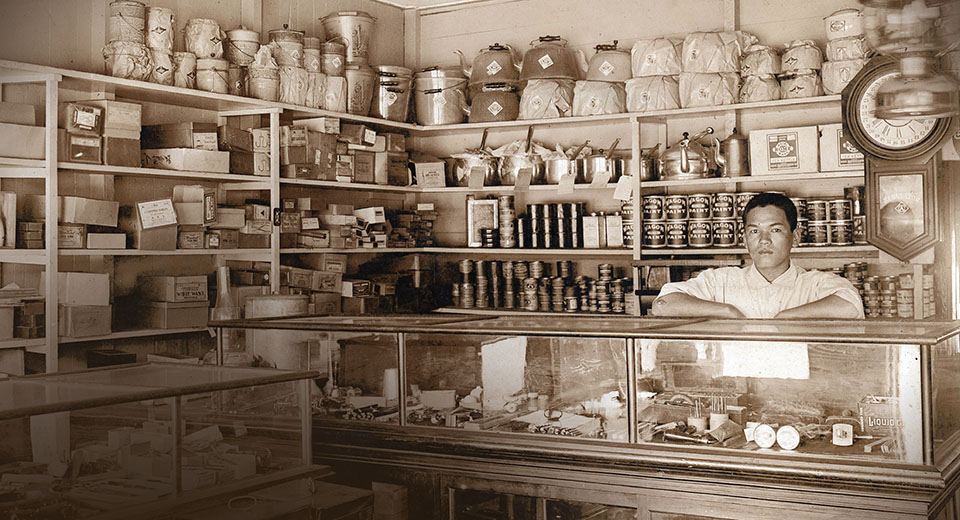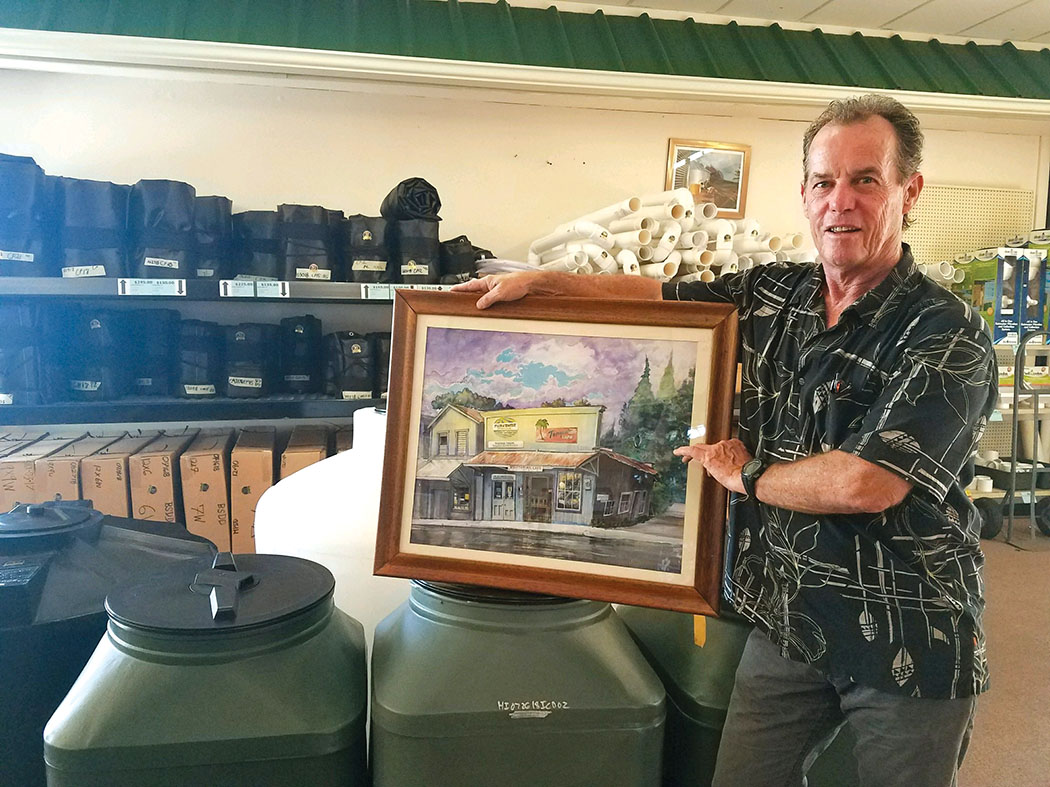
Home Grown to Fulfill a Need: Hawaii Community Federal Credit Union
 By Fern Gavelek
By Fern Gavelek
Businesses come and businesses go, however, the Hawaii Community Federal Credit Union (HCFCU) endures after 80 years. With a charter membership of struggling coffee farmers, the credit union has evolved over eight decades to serve people from all walks of life. How it came to be is a story of caring, necessity, and enterprise.
After the U.S. abolishment of contract labor in the early 1900s, Kona became an attractive haven for former sugar plantation workers wanting a different life. According to The Kona Coffee Story: Along the Hawai‘i Belt Road, Japanese coffee growers were 80 percent of Kona’s coffee farming population in 1910 and by 1930, Filipinos were 12 percent of Kona’s population and “the second largest work force in the coffee industry.”
These independent-minded workers either picked coffee for farmers, or leased land and sold their coffee to a mill. Either way, the coffee industry was a major economic driver and its rigor dictated everyday life along the slopes of Hualālai and Mauna Loa—the Kona Coffee Belt.

After the U.S. entered WWI, coffee prices soared and Kona farmers enjoyed prosperity. Coffee growing was a family venture. Everyone was enlisted, young and old, to prepare the fields, plant and prune the trees, pick the red-ripe coffee cherries, process the fruit, dry the coffee parchment, pack and deliver.
Starting in 1932, public schools observed a later “summer break” from August to November, so keiki (children) were available to work harvest time.
When the Great Depression came to the Territory of Hawai‘i in the 1930s, about 25 percent of Hawai‘i’s labor force was unemployed.
The coffee market was hit hard as people could only afford necessities. Coffee prices declined, drastically reducing workers pay and profit.
Kona farmers sought relief from the few local banks to save their farms—which to some, was their only means of income. Tragically, some farmers defaulted on their loans and lost everything. The number of Japanese farms dropped from 1,070 to 600 between 1930 and 1940.
In 1936, 10 concerned coffee farmers stepped up and founded the Kona Farmers Federal Credit Union (KFFCU), the predecessor of today’s Hawaii Community Federal Credit Union (HCFCU). Charter members were Haruyoshi Akamatsu, Yosoto Egami, Satoru Omoto, Albert M. Shimizu, Yasuki Nakagawa, Wilbert C. Okada, Walter M. Tanaka, Yoshiichi Ujimori, Kiyoshi Oka, and Takeo Matsumoto.
According to HCFCU records, original credit union member Yoshito Fukumitsu recalled, “From about 1927 until 1935, these were rough times. The price of coffee was so cheap. Maybe $3 or $4 for a 100-pound bag of cherry. We had debts every year. That’s when we started to think of something we could do to help each other. So we organized the credit union.”
These financial pioneers, who felt they had to do something to help their fellow neighbors, thought the concept of a credit union seemed a good fit as it resembled the Japanese idea of tanomoshi or “pooled income funds.”
In addition, Congress had recently given legal status to credit unions, institutions organized of people who join their resources to help each other. Credit union members usually live in the same area and are connected in some way—by a club, occupation, school, or company.
Demonstrating the age-old adage, “when there’s a will, there’s a way,” the founders researched how to start a credit union and secured the help of the University of Hawai‘i Cooperative Extension Service and a representative from the National Credit Union Administration.
With humble beginnings, the new credit union boasted 43 original members who paid 25 cents to join and bought shares priced at $5 each.
The credit union operated in the old Kona Experiment Station in Kainaliu, sharing space, and also the on-site, part-time employee, Evelyn Yates. Soon, the credit union relocated to a one-room office in Captain Cook across from the Manago Hotel—where Greenwell Park is today.
Yasunori Deguchi staffed the new office as KFFCU’s first, full-time employee. He was 22 years old. A decorated WWII veteran who served with the 442nd, Yasunori worked at the credit union for nearly 40 years, retiring as vice-president in 1985. He feels the founding of the credit union was “key” for keeping Kona’s coffee industry afloat during the difficult times and for retaining the labor force in Kona. “Otherwise, there would have been an outflow of people to work elsewhere,” he says.
Born to a family of plantation contract laborers who went into coffee, Yasunori details how KFFCU made a difference: “After fulfilling the terms of a labor contract, workers could remain an employee or go independent. Some families tried pineapple or tobacco, but coffee did the best in Kona. It was hard for these immigrants (who had worked on plantations), to get financing and go on their own.”
It didn’t take long for the community to appreciate the efforts of KFFCU and soon farmers of other crops and then local community members wanted to join. This was a win-win as the new credit union depended on its member’s purchase of shares to have available cash for loans.
In 1939, the institution opened its membership to the community and changed its name to the Kona Community Federal Credit Union (KCFCU). The membership jumped to 362 and assets increased 400 percent to $18,267.
In 1955, KCFCU boasted being the largest credit union in the Territory of Hawai‘i and also the first to build its own office. The modest, $30,000 Kealakekua building was constructed of lava rock and redwood and housed four employees. In 17 years, this building was replaced with a $750,000 facility sporting a “wave” design to symbolize the ocean and future. During construction of the 7,000-square-foot building, operations moved above the Kainaliu bowling alley. When the Kealakekua Branch opened in 1973 it was hailed as “the most modern structure in Kona.”
Troubled times came to North Kohala in 1973 when the Kohala Sugar Company closed its doors leaving over 500 unemployed. The closure shuttered the Kohala Federal Credit Union, which formed in 1939 to serve sugar workers and their families. KCFCU merged with that institution and welcomed its members into the KCFCU ‘ohana.
With membership stretching along the leeward side of the island, the credit union expanded its charter to service the entire Hawai‘i Island and was renamed the Hawai‘i Community Federal Credit Union.
A couple years later, HCFCU merged with the Pā‘auhau Federal Credit Union after the areaʻs sugar plantation closed its doors.
Proud of its storied beginnings, HCFCU chronicles its unique history on four, floor-length murals at the John Y. Iwane Credit Union Center, better known as the Kaloko Branch.
Nellie Medeiros, corporate development and marketing manager of HCFCU, sizes up the murals by referring to the old saying, “You have to know where you came from to know where you are going. You have to know who you came from to understand who you are.” She also likens it to the Hawaiian ‘ōlelo no‘eau (proverb): “I ka wa mamua, ka wa mahope,” meaning “The future is in the past.”
She elaborates: “The generation that started HCFCU has long passed on and the current generations of millennials know our history through words and stories. The murals are important as they bring our history to life and perpetuate the efforts of our founders. They show how far we’ve come and how much we’ve grown.”
Nellie’s family has deep roots with the local coffee industry stretching across multiple generations. She says her husband Clarence’s great-great-great-great-great grandfather, Don Francisco de Paula Marin, is credited with bringing the first coffee plant to Hawai‘i. Arriving to Hawai‘i in the early 1800s, Don Francisco was admired for his botanical experiments and coffee came to Kona due to his agricultural endeavors. The family continues to grow coffee today.
Because of HCFCU’s philosophy of “being people of a community who join together to help each other,” the institution and its employees support several charitable organizations and is especially active with the annual Kona Coffee Cultural Festival.
“Because we share the same coffee roots and legacy, HCFCU supports the Kona Coffee Cultural Festival to preserve our mutual heritage,” explains Nellie.
HCFCU has been a festival supporter for more than 25 years, providing financial sponsorship and “sweat equity” for multiple activities like the scholarship pageant and the Grand Parade. This year, the credit union is coordinating the festival ho‘olaule‘a on November 12. The daylong celebration offers entertainment, food booths, Kona coffee vendors, cultural demonstrations and exhibits, educational displays, and more.
“Our support helps ensure the festival continues to be not only an opportunity to promote and perpetuate the heritage of Kona Coffee, but an event that contributes to hometown pride—not to mention it’s a great wholesome time for all ages,” notes Nellie.
Sharing her feelings about how HCFCU came to be, Nellie muses, “I feel proud and privileged to to be a part of a financial institution whose courageous start was founded on the philosophy of people helping people and that vision has not changed from what it was 80 years ago. It is special to me, because the philosophy of working together so everyone benefits is a timeless venture. I personally know the struggles of coffee farmers and the health and continuation of the coffee industry is essential to the economy of West Hawai‘i as a whole. HCFCU’s support of those farmers is our way of remembering where we came from.” ❖
For the full schedule of 2016 Kona Coffee Cultural Festival events: KonaCoffeeFest.com
Photos courtesy Hawaii Community Federal Credit Union
Contact Hawaii Community Federal Credit Union: HiCommFCU.com
Contact writer Fern Gavelek: ferng@hawaii.rr.com


